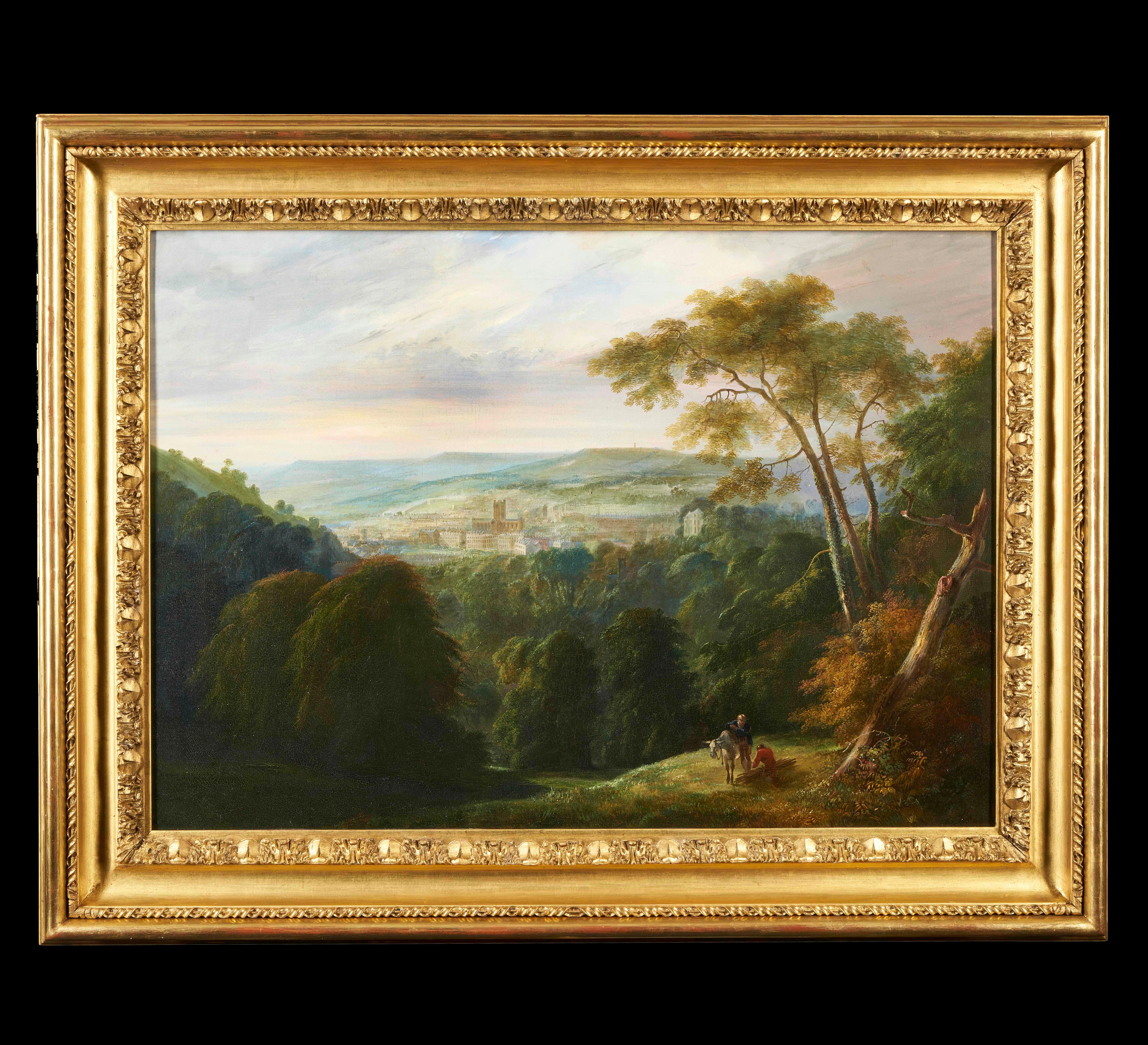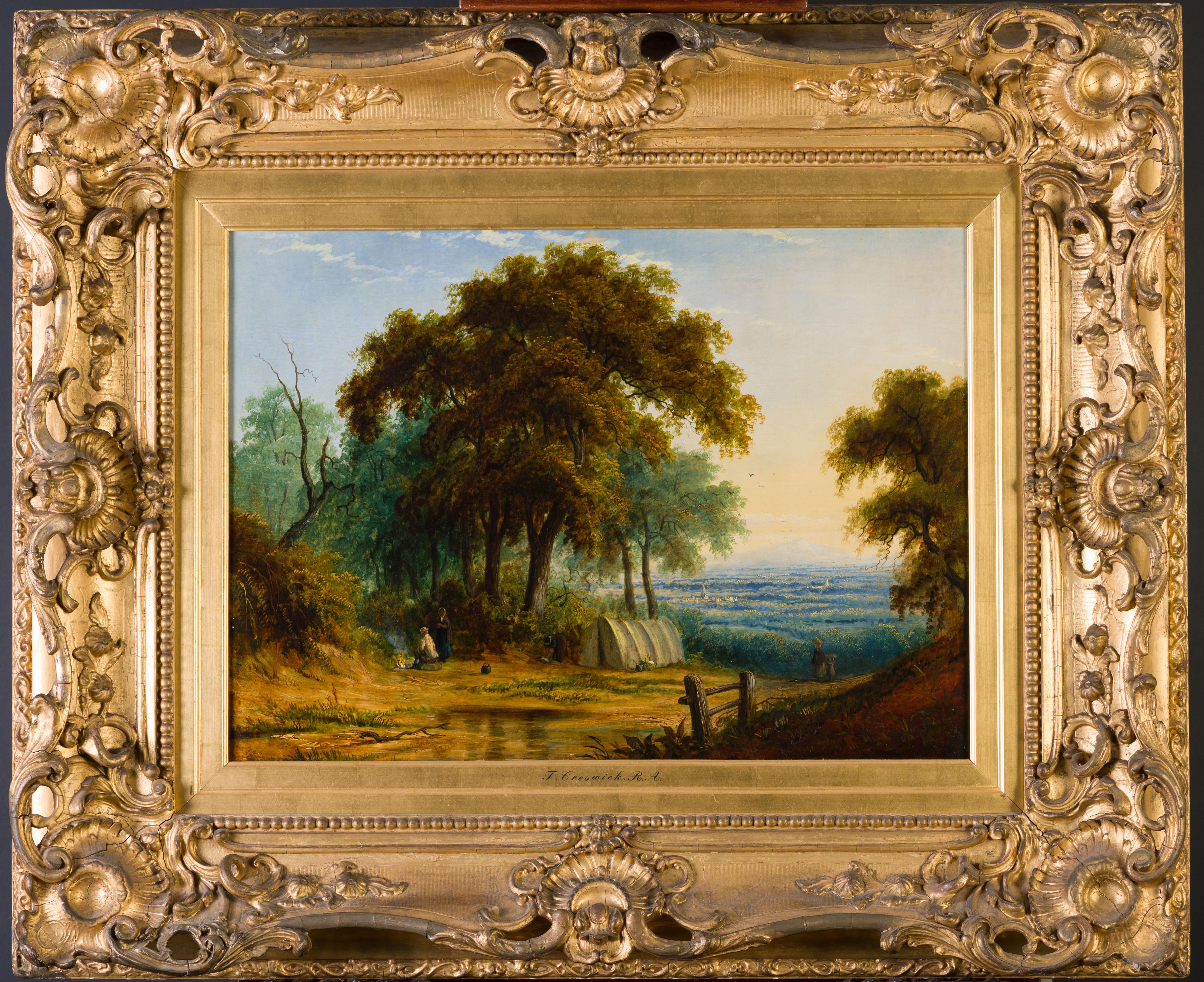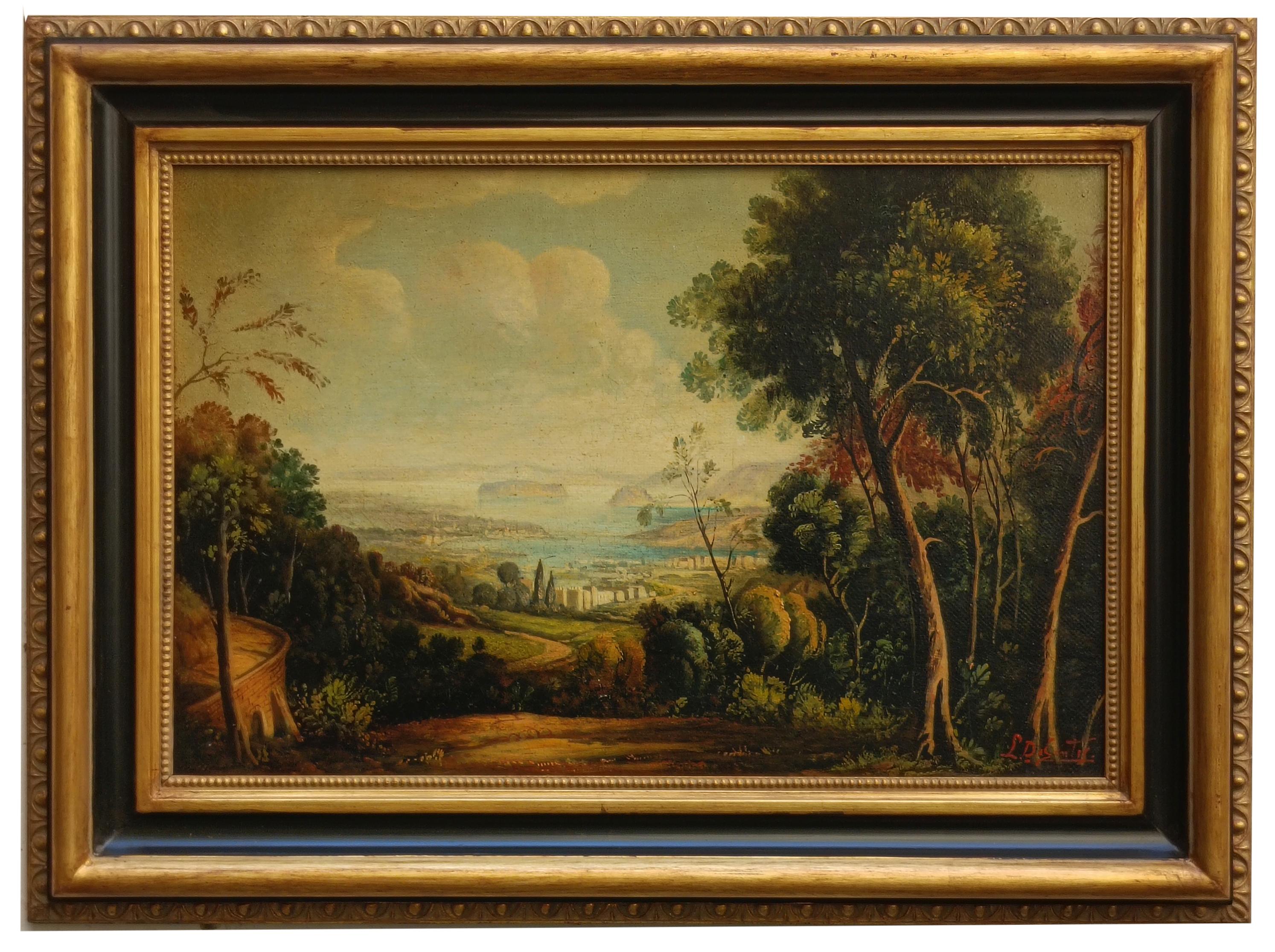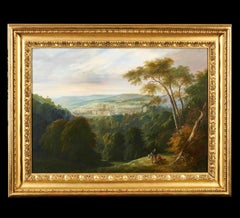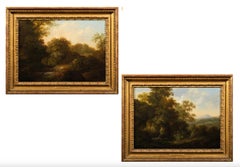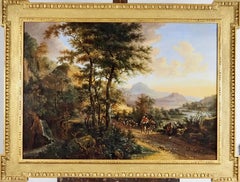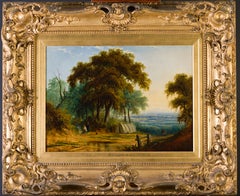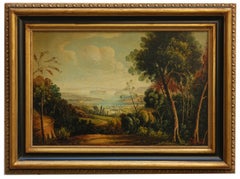Items Similar to A view at Tivoli
Want more images or videos?
Request additional images or videos from the seller
1 of 8
John RathboneA view at Tivoli
$6,883.59
$13,767.1850% Off
£4,975
£9,95050% Off
€5,867.68
€11,735.3650% Off
CA$9,524.16
CA$19,048.3350% Off
A$10,334.20
A$20,668.3950% Off
CHF 5,482.10
CHF 10,964.2050% Off
MX$126,903.11
MX$253,806.2350% Off
NOK 67,795.75
NOK 135,591.5050% Off
SEK 64,202.49
SEK 128,404.9950% Off
DKK 43,799.81
DKK 87,599.6250% Off
About the Item
John Rathbone (1750-1807)
View at Tivoli
Signed lower right
Oil on Canvas
Canvas size - 18 x 24 in
Framed size - 24 x 30 in
John Rathbone was born in Cheshire in 1750 and worked as an artist in Manchester, London, and Preston painting landscapes in oils and watercolours. He gained the name of the ‘Manchester Wilson’. His works in watercolour are well drawn and interesting. The British Museum possesses three of his watercolour drawings, all of which are landscapes including figures. Another work by him exists in the Walker Art Gallery, Liverpool, and a further two hang in the Peel Park Art Gallery, Salford.
Between 1785 and 1806 Rathbone exhibited 48 landscapes at the Royal Academy in london and a further two at the Society of Artists. He exhibited three landscape paintings at the Exhibition of the Society of Artists in Liverpool in August 1774. Rathbone died in 1807.
- Creator:John Rathbone (1750 - 1807)
- Dimensions:Height: 24 in (60.96 cm)Width: 30 in (76.2 cm)
- Medium:
- Movement & Style:
- Period:
- Condition:
- Gallery Location:Stoke, GB
- Reference Number:1stDibs: LU446314280022

About the Seller
5.0
Recognized Seller
These prestigious sellers are industry leaders and represent the highest echelon for item quality and design.
Platinum Seller
Premium sellers with a 4.7+ rating and 24-hour response times
Established in 2009
1stDibs seller since 2016
185 sales on 1stDibs
Typical response time: 1 hour
Associations
LAPADA - The Association of Arts & Antiques DealersInternational Confederation of Art and Antique Dealers' AssociationsThe British Antique Dealers' Association
- ShippingRetrieving quote...Shipping from: Andover, United Kingdom
- Return Policy
Authenticity Guarantee
In the unlikely event there’s an issue with an item’s authenticity, contact us within 1 year for a full refund. DetailsMoney-Back Guarantee
If your item is not as described, is damaged in transit, or does not arrive, contact us within 7 days for a full refund. Details24-Hour Cancellation
You have a 24-hour grace period in which to reconsider your purchase, with no questions asked.Vetted Professional Sellers
Our world-class sellers must adhere to strict standards for service and quality, maintaining the integrity of our listings.Price-Match Guarantee
If you find that a seller listed the same item for a lower price elsewhere, we’ll match it.Trusted Global Delivery
Our best-in-class carrier network provides specialized shipping options worldwide, including custom delivery.More From This Seller
View AllA view of Bath, England
Located in Stoke, Hampshire
Edmund Garvey (Kilkenny 1740-1813)
A view of Bath
Oil on canvas
Canvas Size 20 x 28 in
Framed Size 26 x 33 in
Edmund Garvey (1740 – 28 May 1813) was an Irish landscape painter whose...
Category
18th Century Old Masters Landscape Paintings
Materials
Oil
$13,282 Sale Price
20% Off
View of Matlock High Tor, Derbyshire
By Thomas Smith (b.1720)
Located in Stoke, Hampshire
Thomas Smith of Derby (1720-1767)
View of Matlock High Tor, Derbyshire
Oil on canvas
Canvas Size 25 x 30 in
Framed Size 32 x 37 in
Provenance
Private Collection, London
Thomas Smit...
Category
18th Century Old Masters Landscape Paintings
Materials
Oil
$12,971 Sale Price
25% Off
A pair of Classical landscapes
Located in Stoke, Hampshire
George Smith of Chichester (Chichester 1714-1776)
Landscape with figures resting by a river; River landscape with figures outside a thatched cottag...
Category
18th Century Old Masters Landscape Paintings
Materials
Oil
$10,515 Sale Price
20% Off
Italian landscape with Monte Socrate (after Jan Both)
Located in Stoke, Hampshire
Richard Bankes Harraden (1778-1862)
Italian landscape with Monte Socrate (after Jan Both)
Signed and dated 1823 on the reverse
Oil on canvas
Canvas size ...
Category
18th Century Old Masters Landscape Paintings
Materials
Oil
$10,515 Sale Price
27% Off
A view of Paesteum with Grand Tourists in the foreground
Located in Stoke, Hampshire
Pietro Antoniani (Milan circa 1740-1805)
A view of Paesteum with Grand Tourists in the foreground
Oil on canvas
Painting Size 13 x 19 1/2 in
Framed Size 17 x 24 in
Provenance
Sale,...
Category
18th Century Old Masters Landscape Paintings
Materials
Oil
$24,905 Sale Price
20% Off
A PAIR of Landscapes.
By Abraham Pether
Located in Stoke, Hampshire
Abraham Pether (1756-1812)
'Landscape near Chichester' and 'Drovers in a landscape'
A pair, Oil on canvas
One signed and inscribed 'Chichester'
Canvas size - 16 x 20 5/8 in
Framed si...
Category
18th Century Landscape Paintings
Materials
Oil
$14,334 Sale Price
20% Off
You May Also Like
Extensive landscape
By Thomas Creswick
Located in Douglas, Isle of Man
Thomas Creswick R.A. 1811 - 1869, was an English landscape painter and illustrator. Creswick was one of the leading members of the Birmingham School of landscape painters and exhibit...
Category
1840s Landscape Paintings
Materials
Canvas, Oil
Italian Landscape - Dutch Old Master art Grand Tour landscape oil painting
Located in Hagley, England
This simply stunning large Old Master landscape oil painting is attributed to noted Dutch artist Adriaen van Diest. Painted circa 1700 this Mediterranean Italian landscape painting has everything; A really interesting landscape with land, river, sea and mountains, interesting figures and cattle and a wonderful sky with fading light. The details and the capturing of the light make this a really fantastic Dutch Old Master country house Grand Tour oil painting. Irresistible.
Provenance. Dorset estate.
Condition. Oil on canvas, 42 inches by 20 inches and in good condition.
Frame. Housed in an English carved giltwood frame, 50 inches by 28 inches framed and in good condition.
Adriaen van Diest (1655-1704) was born in the Hague in the Netherlands. Like his father and his brother, he pursued a career as a marine painter, that is, a painter of seascapes and sailing ships. In 1673, attracted by the thriving English market for portraits and marine paintings, he joined the exodus of Dutch artists leaving to work in England. It is thought that his master was Willem van de Velde the Younger...
Category
Early 1700s Old Masters Landscape Paintings
Materials
Oil
$21,584 Sale Price
20% Off
Classical Landscape - French 17th century art Old Master oil painting
By Jean François Millet
Located in Hagley, England
This superb 17th century French Old Master oil painting is attributed to Jean Francois Millet. Painted circa 1670 it is a classical landscape with figures by a bend in a river in the...
Category
17th Century Old Masters Landscape Paintings
Materials
Oil
$19,924 Sale Price
20% Off
LANDESCAPE -French School -Oil on Canvas Italian Landscape Painting
By Luigi De Santis
Located in Napoli, IT
Italian Landscape - Luigi De Santis Italia 2006 - Oil on canvas cm. 40x60.
The painting by L. De Santis is an oil on canvas depicting a neoclassical landscape inspired by Claude Lorrain, a French painter active mainly in Rome who was the most famous landscape painter of the Seicento, considered the master of the genre of the ideal landscape.
Category
Early 2000s French School Landscape Paintings
Materials
Canvas, Oil
19th Century Roman Landscape oil on canvas with Giltwood Frame
Located in Rome, IT
Amaizing 19' century Roman landscape depicting a part of Villa Borghese with Trinità dei Monti.
With a finely carved gilt wood coeval frame.
Measurements with frame cm 65 x78 wit...
Category
19th Century Old Masters Landscape Paintings
Materials
Oil
Paysage Lacustre Animé Att. Göbell Gerrit Hendrik (1786/1833)
Located in GOUVIEUX, FR
Oil on canvas, Dutch school, Gerrit Hendrik Göbell (1786–1833).
This charming painting takes us into a peaceful, verdant landscape bathed in the soft light of evening. In the foregr...
Category
Late 18th Century Landscape Paintings
Materials
Oil
More Ways To Browse
Antique View Master
Antique Preston
Seascapes California Art
Turkish Art Painting
Vintage Church Signs
Christmas Oil Painting
Farmyard Paintings
Green Mountains Painting
Landscape Painting Greece
Luce Maximilien
Moody Landscape Oil
Northern California Artists
Oil Painting Framed Traditional
Painting Of Fountains
Paintings Of Doors
Shower Painting
St Marks Square
Venice Bridge
